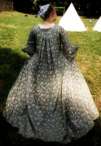| INDEX | 1300-1599 | 1600s | 1700s | 1800s | 1900s | CROSS-ERA | ETHNO | |
| MISCELLANY | CONTACT | SEARCH | |

Having just done the 1680s manteau as accurately as I could, I was hell-bent on making this one accurate as well. I'm not sure I succeeded.
The pattern is based on Waugh's "Cut of women's clothes" diagram XV with considerable influence from Arnold's "Patterns of fashion", p. 34. The panier is part based on Waugh's (in "Corsets and Crinolines"), part on Hunnisett's.
I wanted something wide, as was worn in the 1740s, but not as boxy in shape as so many 1740s English dresses, including the one in Armold. (For some curious reason, as you can see in the picture from behind, it doesn't look so very wide at all - but believe you me, when you try to sit down on a normal chair, it is bloody wide!) The shape of the panier was determined first (kidney), the dress had to follow. Therefore, corset and panier were made first. As the garment was made during a small private workshop, part of the procedure is described in my workshop "diary".
The fabric I used was 100% plastic, but woven into a nice brocade (not printed - yay!) flower design that could pass as period. The basic colour was golden, but unfortunately some bugger had thought that garish green was the colour for the leaves. I ended up treating the inside as the outside, dispensing with the wonderful satin finish with a heavy heart. On the inside, the garish green and a similarly garish violet blended nicely into a greyish green. The bodice is lined with firm white cotton.
For the sole reason that I didn't have enough fabric for the robe and jupe, I decided to make the garment with a closed front as in the Arnold pattern. I used up 8 m, 110 cm wide. 7m would have been barely enough for the robe alone; the jupe is 3.6 m in hem circumference, and on hindsight that's not even enough.
Having made a contouche before, the Watteau pleats weren't much of a challenge. The worst part was adjusting the skirt to the panier: The panier for the Arnold pattern was meant to stick out almost horizontally from the waist, while Waugh required something dome-shaped, but somehow mine sloped in a way somewhere in between. As I had no idea how I could bring the panier into the shape I wanted, I ended up adjusting the dress to fit the panier.
If I let the upper edges of the skirt "wings" project in parallel to the ground, then plunge vertically down as in the Arnold pattern, the fall of the skirt would look ridiculous. I had to let the seam follow the line of the panier: First slightly downwards, then sharply but not vertically down. I folded instead of cut the surplus away, hoping to fit the skirt over a more rectangular panier one day.
The new shape didn't go well with the fan-shaped pleats you usually get at the "corner" of the panier (what corner, anyway?), so after some struggle with the fabric which had found the idea ludicrous from the start, I decided to leave them out. Instead I found that at the hem, the skirt was slightly too narrow, so it didn't drape well over the panier. I set a long triangular gore into each side seam, the tip at the panier corner, to give additional width to the hem.
Then I had to determine the hemline which I did by putting the dress onto a stand with my shoulder height plus heel allowance. I made the hem not quite ground length minus 5 cm in front, easing it down towards the sides, then letting it lengthen into a small train of 30-some cm. What I should have done before wearing the costume for the first time is to set a bias-cut strip of no-nonsense fabric against the inside of the hem to protect it from street soil and wear. I have done so by now: a 15 cm wide bias strip of NATO-olive gabardine - oh dear, that was a vintage fabric! I think my mother'd intended it for trousers back in the 70s.
The sleeves were put in last, as always. I love the huge cuffs! They are lined with some rough taffeta-like silk, Honan I think. I've puzzled quite a bit about them: According to the pattern (Arnold), they are only stitched to the sleeve in front and around to the sides. But then if you looked from behind and above, you could look through the wing of the cuff straigt down to the sleeve hem and the elbow! The pattern gives a rectangular piece that would go there, but how exactly? It seemed most logical to sew it round the upper opening of the cuff wing, but somehow it doesn't feel right either... This is what it looks like.
I'm not quite happy with this opus (when am I?) because of the many improvised alterations: A period seamstress might have done the same, but then she might have died of shame. I would have liked the panier to be a bit more horizontal at the top, and the fabric to be of natural fibre. I would have liked to have more fabric, and a lighter one. This one is very fluid, doesn't like to stay pleated, and pulls at the back of the neckline with its weight. Oh well - next time!
Content, layout and images of this page
and any sub-page of the domains marquise.de, contouche.de, lumieres.de, manteau.de and costumebase.org are copyright (c) 1997-2022 by Alexa Bender. All rights reserved. See Copyright Page. GDPO
This work is licensed under a Creative Commons License.